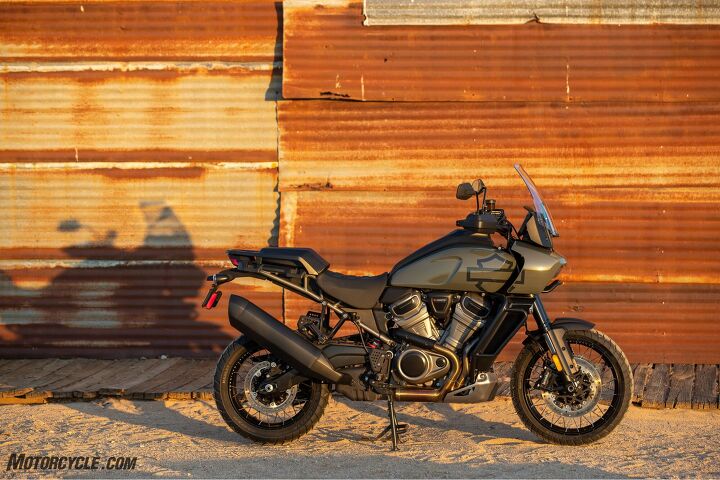Best Technology Of 2021

Best Technology of 2021 Harley-Davidson’s Adaptive Ride Height
One of the biggest barriers to entry that adventure bikes face is seat height. Most folks, unless they’re well over six feet tall or simply have experience dealing with them, will have an issue with tall seat heights. At the peak of skyrocketing saddles, the Honda Africa Twin Adventure Sports was topping out at 36.2 inches. Adventure motorcycles face the challenge of balancing reasonable seat heights while still delivering enough ground clearance and suspension travel to make them worthy of the nomenclature. While dirt bike benches regularly top 37 inches, they also weigh under 250 pounds and are narrow. Adventure bikes, on the other hand, can tip the scales at more than double that.
The Adaptive Ride Height feature available on the Harley-Davidson Pan America is the most innovative solution to this issue that motorcycling has yet to see. Previously, you would have to pay to lower the suspension, purchase a “low” seat option or would otherwise just be SOL. The Pan America’s semi-active Showa suspension components, when fitted with ARH, lower the motorcycle as it comes to a stop by one to two inches. In the Auto setting, the adjustment goes unnoticed and speeds up or slows down its descent based on a number of factors such as speed, deceleration rate, and lever state. The system won’t start lowering until speed is reduced to approximately 15.5 mph. There are also Short Delay and Long Delay modes which lower the motorcycle 0.5 seconds and 2 seconds after the machine is stopped. The suspension can also be locked out for off-road riding scenarios where maximum ground clearance is necessary.
This new feature truly opens the door to riders who may have been interested in adventure machines in the past, but came up, uh, short. As many people have said in comments throughout the internet, we’re not sure why it took this long to attempt an innovative solution for ever-rising seat heights, but we’re thankful that Harley-Davidson took the challenge.
Best Technology of 2021 Runner-Up: Adaptive Cruise Control
Remember when simply having cruise control was a luxury reserved for only the most massive of touring rigs? Now, we complain when a ride-by-wire bike doesn’t have one. (Case in point, our recent naked bike shootouts in addition to Senior Editor, John Burns, saying he will never buy another motorcycle without cruise control.) Now, the manufacturers are seriously upping their game. We first seriously considered adaptive cruise control way back in 2018 when Ryan Adams visited Bosch’s facilities in Germany to learn what plans the company had in mind for “rider assistance technology.” Though still in its early stages of implementation (requiring large, noticeable sensors on the front of the motorcycle), we here at Motorcycle.com think the technology has moved over from intriguing technology to an essential part of any motorcycle that has the word “tour” in its description.
Convenience aside, the advantages of adaptive cruise control are clear. Touring riders frequently do things, like checking the GPS screen, that will momentarily redirect their eyes from the road. Adaptive cruise control can sense the car that changes lanes and begin modulating speed decreasing a rider’s reaction time. From here, we are only a short distance away from blind-spot detection warnings and the increase in safety that brings to crowded urban environments. And that’s before we even consider the convenience adaptive cruise control brings.
Cruise control has been a great advancement, but when riding in a group, it requires constant tweaking up and down to maintain a reasonable riding formation. With adaptive cruise control, the rider can determine the following distance they are comfortable with and set the parameters accordingly. Riding back from the BMW R18B introduction required a final day of freeway droning, and the convenience of simply pulling up behind a car in the left lane and then accelerating away when they moved out of my way can’t be understated. Now, add that to a multi-timezone tour, and the importance for long-distance riders becomes obvious.
Because of the safety and convenience implications, adaptive cruise control is the runner-up for the Best Technology MOBO.
Motorcycle.com Best of 2021 Categories
Become a Motorcycle.com insider. Get the latest motorcycle news first by subscribing to our newsletter here.

Ryan’s time in the motorcycle industry has revolved around sales and marketing prior to landing a gig at Motorcycle.com. An avid motorcyclist, interested in all shapes, sizes, and colors of motorized two-wheeled vehicles, Ryan brings a young, passionate enthusiasm to the digital pages of MO.
More by Ryan Adams












































Comments
Join the conversation
"From here, we are only a short distance away from blind-spot detection warnings and the increase in safety that brings to crowded urban environments."
Short distance? Ducati already has it, but lets give the award to a suspension that lowers to provide a minor convenience instead of a life saving safety feature, then pretend that feature doesn't exist. Disappointing, MO.
The adaptive cruise control should be #1. Not everyone cares about adaptive ride height. Everyone could benefit from adaptive cruise.